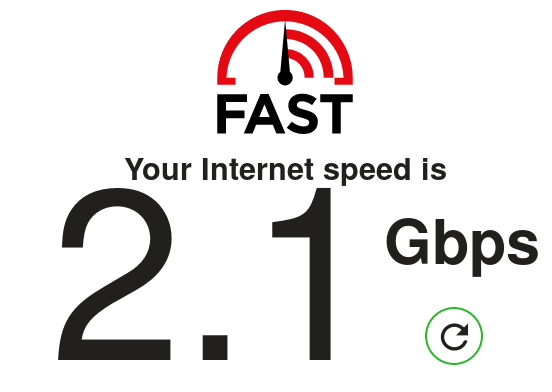
- #Fast.com internet speed test how to#
- #Fast.com internet speed test full#
- #Fast.com internet speed test tv#
If your AT&T Internet speed test result is lower than expected, try Note: This speed test can be used to test any internet provider, not Often referred to as “lag,” latency is a description of the time it takes to send a ping to a given server and receive it back at your local device again.Whether AT&T Internet is your internet provider or you use a different provider, the speedĬan show key statistics about your internet connection. This measurement is reflected as latency on a network. You will usually see this represented as a “ping rate,” which simply measures how much time passes during the process of sending the signal and receiving it again. Ping simply refers to a signal that is sent from a given device to a server, and back again. Unlike bandwidth, however, this is a measurement of volume, not speed. Throughput is very similar to bandwidth, in that it is a measurement of the amount of data that passes from one point to another within a certain amount of time.

During certain times of peak traffic, you may experience slower speeds.
#Fast.com internet speed test full#
ISP’s commonly advertise the best case scenario bandwidth when showing the speeds offered in their internet plans.įor example, if a provider lists a download speed of 25 Mbps, this figure is based on the full capacity (bandwidth) of the company’s network. You can think of bandwidth as the total capacity a given network has in terms of data. No currently operating consumer networks utilize this measurement. Faster connections are measured this way. The most common unit of measurement for modern internet connections. Only the slowest connections are measured this way. Transfer rates are commonly described using a bits-per-second measurement. This can be done through the internet, or locally, such as transferring photos between a flash drive and your computer’s local storage. Simply put, transfer rate refers to how quickly data is transferred between two or more devices. There are 1 billion bytes in a Gigabyte (GB). There are 1 million bytes in a Megabyte (MB). Since bits are such a small unit of measurement, it makes more sense to use bytes when discussing file sizes.įor example, there are 1,000 bytes in a single Kilobyte (KB). There are 1 billion bits in a Gigabit (Gb).Ī byte is a common unit of measurement for determining how large a particular piece of data is. There are 1 million bits in a Megabit (Mb). These are the ones and zeroes that make up binary code.įor reference, there are 1,000 bits in a single Kilobit (Kb).
#Fast.com internet speed test how to#
Speed Test Terms: How To Understand Your Results Bitsīits are foundational units of measurement for digital data.
#Fast.com internet speed test tv#
Streaming multiple TV shows or movies at the same time (especially 4K media) and downloading large files are both examples of activities that require higher download speeds than average. Almost all activities require a certain amount of download speed, so this is the main number you’ll want to pay attention to when deciding how much internet speed you need. Download Speedĭownload speed refers to how quickly your connection can retrieve data from a website or server online. Some do, however, including Skype and other video chat services, online gaming, and large cloud storage applications like Dropbox and Google Drive. In short, most activities online do not require high upload speeds. This number is often not the one heavily advertised by service providers online, and this is on purpose. Upload speed refers to how quickly your connection can send something (data, in this case) from your device to the wider internet. In order to better understand your internet speed test, it is vital to know the difference between upload speed and download speed. Understanding Your Internet Speed Test Results The speeds advertised by internet providers are based on the speed you get with a device wired directly to the router using an ethernet cable. Keep in mind that using WiFi tends to reduce performance. This will often solve the issue, but not always.

If you test your connection multiple times and find that you aren’t getting what you’re paying for, we recommend reaching out to your ISP for help. Running our internet speed test is the best way to determine if your provider is actually holding up their end of the bargain.
/netflix-fast-speed-test-a3b4381536c3490d8da97469db1dfc0f.png)
Then there’s the flipside you may be paying for speeds you’re not actually getting.

Based on the information above, if you find that your internet speeds are higher than needed, we’d recommend reaching out to your ISP (Internet Service Provider) and switching to a lower-cost plan. You may be paying for more speed than you actually need, and these additional fees could be costing you month after month. For one, it could potentially save you some money.


 0 kommentar(er)
0 kommentar(er)
